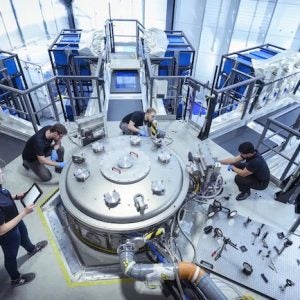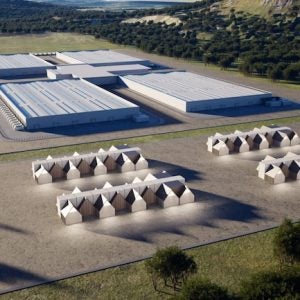The design intent of part of the Sellafield Thermal Oxide Reprocessing Plant (Thorp) had been missed early in the plant’s life. As a result, a feed pipe carrying spent nuclear fuel dissolver fluid was under unplanned-for stress and after 11 years of operation began to fracture. Over a period of about nine months a crack developed unknown to operators allowing the liquor to accumulate in the sump of a sealed cell. Operations staff then failed to act appropriately to consequent off-normal conditions, according to British Nuclear Group’s board of inquiry report.
It was over a month between the first clear signals that something was wrong and plant shutdown. If abnormal results had been questioned and sampling procedures followed it is possible the problem would have been recognised seven months before that.
The BNFL board of inquiry launched an investigation into the leak which Thorp operators British Nuclear Group passed on to Sellafield’s owners, the Nuclear Decommissioning Authority (NDA). BNG took the step of releasing it partly due to the number of requests made for it under the Freedom of Information Act. The period of secrecy put the NDA in a difficult position: they are required by law to share their information with all stakeholders.
The released version is largely uncensored. Paul Vallance, spokesman for BNG, said: “The reason we initially felt disinclined to release the report was that we wanted to ensure it would be a very full, frank, no-holds-barred report. There was a genuine concern that if it was published, perhaps people may not be as forthcoming and we may not get to the bottom of what went wrong.”
The exceptionally frank report lists the following management systems as having shortcomings which contributed to the event: safety case; procedures and systems of work; hazard reporting systems; training; supervision; design; maintenance; and plant modification. The report states that a ‘new plant’ culture existed and Thorp was simply not expected to leak.
PROCESS AND ACCOUNTANCY
Flasks containing spent nuclear fuel (SNF) are transported to Thorp from customers in Japan and Europe by ship. After docking at BNFL’s Barrow-in-Furness terminal facility the flasks are taken to Sellafield where they are stored before their contents are removed at Thorp.
PWR and BWR spent fuel rods are sheared, cutting both the steel rods and the fuel they contain into small chunks which are then emersed in 2.9M nitric acid in the dissolver cell. The SNF is dissolved into a highly radioactive liquor which still contains small residual pieces of steel that must be removed – a centrifuge process called clarification.
The liquor is passed to cell 220 for clarification, accountancy and buffer storage. After clarification, liquor containing 250g/l uranium is sent to one of two 23m3 accountancy tanks, V2217 A and B (see Figure p11).
During accountancy, the tanks are sequentially agitated by internal mechanisms to ensure samples taken are representative of the contents as a whole. The tanks are alternately filled, weighed and emptied and the liquor is transferred to one of three buffer storage tanks.
HOW A PIPE FAILED
The two accountancy vessels in cell 220 operated suspended from the ceiling. They were routinely rested for short periods on a steel frame for weighing and for calibration and for this reason, the tanks’ original design allowed vertical movement. Lateral motion was prevented by a restraining system, partly to reduce induced stresses from pumping devices.
However, when the safety case for the basis of design was produced, the vessels were seismically uncoupled from their steel frame. To accommodate this change, it is clear from visual evidence, said the board of enquiry report, that restraint blocks were not fitted and that some steelwork had been modified to provide additional space between the vessels and the steel frame.
It appears that the design intent was modified at some point after the original design, but before early commissioning. No evidence was found that the design was reviewed to consider fatigue following the modification. The board of enquiry found it ‘inconceivable’ that, had fatigue calculations been performed, it would have been thought acceptable to operate the vessels without lateral restraint.
Evidence exists that the vessels vibrated during the operating cycle. The amplitude of the vibration has not yet been positively identified but was probably less than ±1-3mm at the point of failure. The vessels had undergone in the region of 800,000 cycles over 11 years of operation before the stresses caused by vibration led to fatigue cracking at the part of a feed pipe where a nozzle entered vessel.
There is evidence to suggest a staged failure of the pipe by crack development and propagation before a more significant failure. It is thought this process began as early as July 2004, with a step change in leak rate occurring in 15 January 2005. Ultimately, just over 83m3 of liquor was to leak from the pipe and accumulate in a sump on the cell floor.
DISCOVERNIG THE LEAK
BNG was very slow to notice that nuclear material was going missing in cell 220. The simplest way to identify loss of fluid into the cell would have been through monitoring of the sump level indicators. This opportunity was missed.
Cell 220 was fitted with a sump and a device known as a pneumercator to measure liquor level. Its purpose was to warn operators of liquor loss as part of the criticality safety case and was not part of the radiological safety case.
The instrument fitted in cell 220 had a history of erratic alarms and over an eight month period to March 2005 had flagged a ‘Lo’ or ‘Lo-Lo’ status over 100 times. There is evidence the alarm was investigated on 8 and 9 December 2004 and no corrective action taken. Operational staff were unaware of problems surrounding sump level measurement.
On 15 January 2005 the sump level indicator showed a rapid 8cm increase in sump level. This was accompanied by a 3ºC increase in temperature readings inside the cell. Given that this event coincided with the reported step change in leak rate mentioned earlier and an extended period of vessel agitation, it is clear that the pipe’s condition significantly worsened on that day.
The temperature was to continue increasing until the leak was discovered but unfortunately, cell temperature is not a parameter that operators would normally monitor. The sump level subsequently returned to normal and at the time the leak was discovered, the pneumercator was reporting a normal level.
Investigation showed that the pneumercator was stuck and had been misreading for some time. The instrument was remotely reset and its reading jumped from 0.2m to 1.8m – indicating a large volume of liquid was present in the sump. That reading also drifted down, prompting the replacement of the instrument.
In the absence of a working sump level indicator, BNG was alerted – albeit rather slowly – by a calculation made on Thorp’s performance, the shipper-receiver discrepancy (SRD) which gives a percentage difference between nuclear materials entering the system in SNF and those recovered by reprocessing.
Three campaigns of work were affected by the leaky pipe:
- Campaign A, carried out between 14 July 2004 and 3 August 2004.
- Campaign B, 9 September 2004 – 29 January 2005.
- Campaign C, 31 January 2005 – 25 February 2005.
The green group Cumbrians Opposed to a Radioactive Environment (CORE) has reported the three campaign materials’ origins as Dodewaard, Beznau and Unterweser respectively and claims that AGR campaigns may also have been affected.
The first signs of a problem reached BNG around August 2004 when campaign A’s SRD was above normal operating margins (0.59% instead of ±0.45%). Although this was not a significant discrepancy, the board of enquiry report says that in hindsight this could have been an early indication of a problem.
The first clear indication of an accountancy issue was an SRD of 3% noted on 17 March 2005 with respect to campaign B. This was confirmed by an independent check, but the SRD was thought to be an error due to the complexity of the calculations, and work continued.
Five days later a meeting was called by the safeguards department to review the results. Because initial figures for campaign C indicated no significant loss, the problem was thought to have been limited to campaign B and caused by a calculation error. Work continued, although a recheck of campaign A’s SRD on 22 March still indicated an unusual discrepancy. The safeguards department accelerated final balance calculations for campaigns A and C.
Final results for campaigns A and C were received on 13 and 14 April respectively. The figures showed SRDs of 3.9% and 9%, representing discrepancies of over eight and 20 times normal operating allowances.
Until three consecutive high SRDs were reported, all levels of operational management had been unaware of mounting concern amongst accountancy and safeguards staff. It was now clear that something had gone wrong and it was decided to trace sample results from the sump at the bottom of the feed clarification area of cell 220.
Operating instructions concerning the sumps in cell 220 are classed as ‘category B’ and there was no evidence of compliance record sheets being completed since December 2000. The instructions have been criticised in the report as being ambiguous – it is left at the operator’s discretion to to decide what level changes would be considered ‘unexpected’.
What’s more, the instructions had in the past been modified, with the change being signed as understood by staff members present at the time. New staff members had not seen the change documents, and there was no way to track training against category B instructions.
Sampling sump contents involves ejecting material from the sump into a catcher pot which is then sent for laboratory analysis. Mistiming the sampling procedure can mean an empty pots is sent – a nil sample.
Cell 220 has two sumps, one beneath the feed clarification equipment, another beneath the accountancy and buffer vessels.
Since July 2003 nine nil samples were taken from the buffer sump – on only two of those occasions were attempts repeated. And while the pipe was leaking, there were five nil samples taken with no second attempt. Operational staff were unaware of these problems.
In fact, since July 2003 only one successful sump sample was taken. On 28 August 2004 a sample indicated 50.1g/l U present in fluid in the buffer sump. However, this data was not available to decision-makers. Because a computer link between the laboratory and management systems was down, the data was faxed for manual input – something which was not to happen until the time the leak was discovered.
Despite the lack of data concerning the buffer sump, the liquor could still have been detected via samples from the clarification sump because the process of sampling transfers material from one to the other. A sample from the clarification sump in November 2004 indicated 9g/l U; another in February 2005, 61g/l U. There is no evidence that these results were acted upon.
The basis of Thorp’s design is for clean sumps. The board of enquiry report states: “It is not credible to get a positive uranium result of the magnitude observed unless it was from a significant leak.” The board of enquiry report concludes that among operators there was a lack of attention to sump samples and a lack of understanding of the significance of sample results.
DELAYED SHUTDOWN
A camera inspection of cell 220 was requested on 15 April and stipulated to have priority over production and be carried out over the weekend of 16-17 April. However, operations managers were unaware of the underlying reasons for the inspection and thought it was unreasonable for the shift team to undertake all the work. The camera inspection was put off until Monday 18 April but in fact the plant shutdown and inspection occurred on 19 April and the body of liquor was discovered in the buffer area on 20 April.
Mass balance calculations completed on 18 April confirmed that about 19 tons equivalent of uranium in about 85m3 of dissolver fluid had been lost from the primary system over the three campaigns.
NEW PLANT CULTURE
Operation culture at the Thorp’s head end was complacent with regard to detecting losses which were simply not considered credible. The board of enquiry report says that all the staff interviewed as part of the investigation believed that losses on this scale could not conceivably be due to a leak – there had to be an error in the paperwork.
Although Thorp was built to the highest standards, it has had problems in the past. In 1998 it was found that a hole had developed in a pipe in the dissolver cell. Material had been leaking for years and went unnoticed despite sump level, sump sampling and contamination evidence of a problem. At the time, recommendations were made about sump monitoring, but these seem to have been forgotten.
In February 2005 workers were ‘grossly contaminated’ because they carried out work in a part of the dissolver cell where leaked highly active liquor had accumulated. This was put down to a ‘new plant culture’.
The current problem had all the hallmarks of previous problems, yet went undetected anyway.
REGULATOR RESPONCE
The UK Nuclear Installations Inspectorate conducted its own investigation into the leak. Part way through the investigation, two improvement notices were served on BNG.
The first improvement notice relates to licence conditions 34(2) (to ensure that no leak or escape of radioactive material can occur without being detected) and 28(1) (to make and implement adequate arrangements for the regular and systematic examination, inspection, maintenance and testing of all plant which may affect safety). The notice requires BNG to ensure leaks are adequately detected, and that any means of detection is adequately maintained and tested.
The second notice relates to licence conditions 24(1) (to ensure that all operations which may affect safety are carried out in accordance with written instructions) and 25(1) (to ensure that adequate records are made of the operation, inspection and maintenance of any plant which may affect safety). This notice requires BNG to have adequate instructions for sampling the containment sumps for leaks and responding to sump level alarms, and to ensure adequate records are kept.
Both improvement notices were served at Sellafield on 17 June, and BNG has until 8 October to comply, although it could appeal.
AN OPTION FOR RESTART
The NDA will be very keen to get Thorp back into action – the outage is reportedly costing £1 million ($1.74 million) per day in lost revenue. Although the profit from operations is passed from owners the NDA on to government, the NDA’s budget depends on its contribution to government funds. In effect, this costly problem is likely to take funds from the NDA’s stated focus, the national decommissioning objective.
Through the Freedom of Information Act, CORE obtained a report from BNG to the NDA on possible options for restarting Thorp. Because cell 220 is a highly active area and remote repair of the broken pipe looks extremely difficult, what BNG describes as the “most appropriate” option is the restart of the plant with tank B bypassed. Accountancy tank A, which has a more flexible pipework arrangement unaffected by vibration stress, would be used as a pumping tank, and accountancy would take place in downstream buffer storage tanks.






